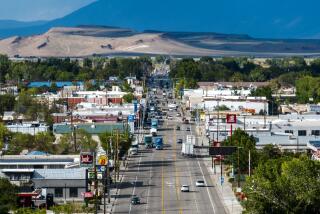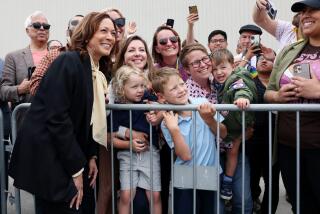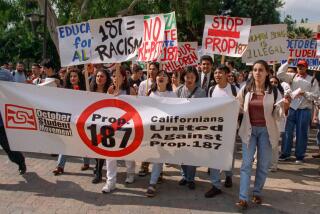Close Vote in L.A. County Helped Bush in State Victory
George Bush won California by one of the slimmest margins in history--309,000 votes--by running surprisingly close to Michael S. Dukakis in Democratic Los Angeles County, according to election results and to the Bush campaign.
Dukakis beat Bush in the county by only 137,000 votes out of 2.4 million cast.
Analysts in both parties thought Dukakis would do much better, and had he won the county by the 500,000-vote margin they thought possible, he would have offset the 300,000-vote margin Bush had in Orange County, and won the state.
Better Than Expected
“We did a whole lot better in L.A. County than we ever expected,” said William Lacy, director of Bush’s effort in California.
Dukakis’ California manager, Tony Podesta, said, “The perception that Dukakis was weak on crime killed us in parts of L. A. County.”
Lacy noted that Dukakis did better in more liberal Northern California than he had to to win, had the Los Angeles effort been on track.
Dukakis won Contra Costa County east of San Francisco, for example, even though the trend there has been Republican for some time.
One reason may have been Dukakis’ voter turnout operation, which was the most extensive in the state but varied widely in its quality.
Interviews and checks by The Times found that it worked well in the San Francisco Bay area but probably lagged in Los Angeles County.
Struggled With Process
Visits to several Los Angeles County precincts on Election Day found that Dukakis volunteers assigned to find which targeted voters were not coming to the polls were still grappling with the process long after they should have mastered it.
It involved using computerized lists of “occasional” voters who were Dukakis supporters but needed a push to get to the polls.
“They were on the right track with their voter turnout operation,” said Lacy, “but I think they made a couple of major mistakes. One was in not inoculating Dukakis early on the crime issue and the other was in not spending more time trying to persuade swing Democrats to back their cause.”
Californian Brian Lungren sent two pieces of Bush direct mail to 1.2 million carefully targeted swing Democrats, charging that Dukakis was weak on crime and thus raising the element of risk. Dukakis’ Boston advisers rejected a major direct mail effort even though California is a pioneer in that method of persuading voters.
Also, Bush came into California right after the GOP convention in August and hammered Dukakis at will on gun control and the death penalty. Dukakis not only took his time responding, but had no strong defenders ready to speak on his behalf.
‘Closing Fast Near End’
“But they were closing fast near the end,” Lacy said. “The reason is he finally got a message that appeals to Democrats here, who we always thought wanted to find a reason to vote for Dukakis.
“His populist message--’I’m on your side,’ was very effective, I think, but then he did the strangest thing in the final weeks. Just when the conservative Democrats were opening the door to him again he went to the San Joaquin Valley, one of the most conservative parts of the state, and said, ‘I’m a liberal.’ He slammed the door on them. We couldn’t believe it.”
The Bush campaign also had its strategy for California ready long before the GOP convention in mid-August. By contrast, Podesta arrived in mid-summer to find nothing set up and spent much of his time arguing with Dukakis’ Boston advisers over how the state should be approached.
More to Read
Get the L.A. Times Politics newsletter
Deeply reported insights into legislation, politics and policy from Sacramento, Washington and beyond. In your inbox three times per week.
You may occasionally receive promotional content from the Los Angeles Times.










